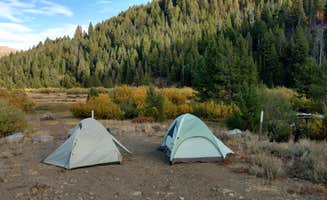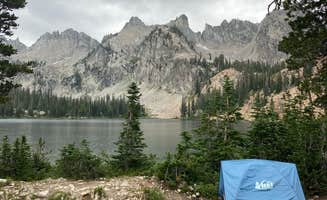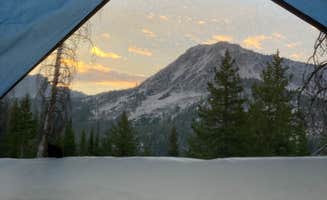Tent camping near Fairfield, Idaho offers secluded sites within the Sawtooth National Forest at elevations ranging from 5,000 to 7,000 feet. The camping season typically runs from late May through September, with snow possible at higher elevations well into June. Most primitive campgrounds in this region require visitors to travel on unpaved forest service roads that can become challenging after rainfall.
What to do
Hot springs exploration: Several natural hot springs are accessible from Fairfield-area campgrounds. At Pioneer Campground, campers can enjoy relative solitude while exploring nearby thermal features. According to Alan B., "With this campground you'll get solitude most weekends as most people heading into the Sawtooths go to the Sun Valley Area."
ATV riding: The remote terrain surrounding Pioneer Campground provides excellent off-road opportunities. "Since it is so remote you can also ride around on ATVs pretty much anywhere. A good escape if you dont feel like going a little deeper," notes Alan B.
Creek exploration: Many campgrounds feature adjacent streams for fishing or wading. The Upper Narrows Campground positions campers directly alongside flowing water. Alan B. reports, "This campground lies near a beautiful stream and has seclusion all around you! The area is best explored by motorized vehicles as theres not many hiking trails."
Mine exploration: From Little Smoky Campground, adventurous campers can access historic mining areas. Alan B. recommends, "If you have an ATV you can cross the creek to the north which has a pretty washed out road but leads to old mines and beautiful views."
What campers like
Stream sounds: Many campers appreciate the natural soundtrack provided by running water at creekside sites. At Little Smoky Campground, which sits adjacent to a creek, one camper notes it's "A great spot to camp if 5 points is full and you dont have horses to take up to the horse camp north of here."
Outpost access: Despite the remote feeling, some Fairfield camping areas offer limited services nearby. Alan B. mentions that near Little Smoky, "Theres hotsprings nearby to the east and a little outpost at the 5 points branching."
Cattle watching: The working ranch landscapes surrounding some campgrounds add to the authentic Idaho experience. At Carrie Creek Campground, Steve S. notes there "May be some cattle at times," providing a glimpse of Idaho's agricultural heritage.
Wildlife viewing: The Sawtooth National Forest hosts deer, elk, and numerous bird species. Many campers report dawn and dusk sightings from their tent sites, particularly at the more remote camping areas that see less human traffic.
What you should know
Road conditions: Access to many tent sites requires traveling on unmaintained roads. Steve S. cautions that at Carrie Creek, "Roads may be tight in bad weather." High clearance vehicles are recommended for most forest service roads in the area.
Facilities limitations: Most tent campgrounds lack amenities. Steve S. notes about Carrie Creek: "No facilities that i recall." Campers should prepare to be self-sufficient with water, sanitation, and waste management.
Limited cell service: Communications are unavailable throughout most camping areas. Tent campers should plan routes and inform others of their location before heading into the backcountry.
Elevation considerations: Many campgrounds sit at elevations where temperatures can drop below freezing even in summer months. Night temperatures can fall 30-40 degrees below daytime highs, requiring proper sleeping gear regardless of season.
Tips for camping with families
Strategic campground selection: Choose sites with natural features to occupy children. At Narrows Campground, the adjacent stream provides natural entertainment. Alan B. confirms the campground "has seclusion all around you" while offering creek access.
Wildlife awareness: Teach children proper food storage techniques as bears and smaller animals frequent the area. Hang food at least 10 feet high and 4 feet from any tree trunk.
Weather preparation: Mountain conditions change rapidly, with afternoon thunderstorms common in summer months. Pack extra layers and rain gear even for overnight trips.
Water safety: Creek levels can rise quickly after rain. Children should always be supervised near water, and campers should set up tents at least 200 feet from waterways to avoid flash flood dangers.
Tips from RVers
Size limitations: Most tent campgrounds near Fairfield cannot accommodate large recreational vehicles. Five Points Campground and other primitive sites have narrow access roads and tight turning radiuses unsuitable for trailers or motorhomes over 20 feet.
Alternative options: RV campers seeking hookups should consider campgrounds farther north toward Stanley or east toward Ketchum, which offer more developed facilities while still providing access to Sawtooth National Forest.
Generator etiquette: If tent camping with a portable generator, respect quiet hours (typically 10pm-6am) and position generators away from neighboring sites to reduce noise impacts.





